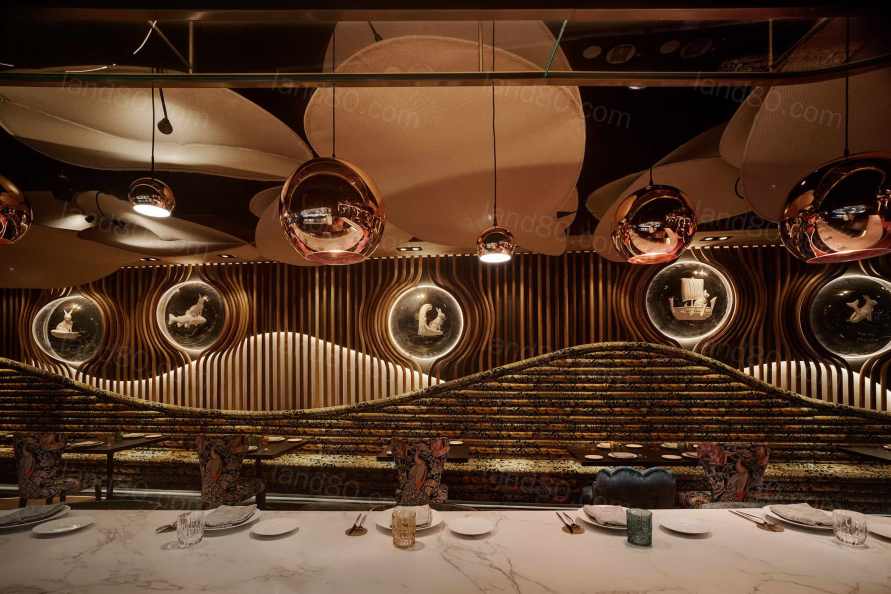Odiseo是创建一个大型城市休闲综合体的愿望的结果,它希望成为一个参考,不仅是穆尔西亚市,而且是整个西班牙东南部地区。该建筑的总建筑面积为15500平方米,包括两个餐厅、一个夜总会、一个表演厅、一个赌场和一个体育酒吧,以及两层地下停车场。
Odiseo is the result of the desire to create a big urban leisure complex, which wants to become a reference, not only for the city of Murcia, but for the entire south east region of Spain. Covering a total built area of 15,500 m2, the building houses two restaurants, a nightclub, a performance hall, a casino and a sports bar, as well as two parking levels undeground.

该建筑位于城市的主要入口之一,周围都是高速路(那里的景观被购物中心和其他企业的广告牌和标志所占据),该建筑试图使自己在不吸引外部标志杆的情况下,成为一个巨大的图腾,容纳空气和植被,旨在从360度的角度来欣赏运动。
Located in one of the main entrances to the city, surrounded by high-speed roads (where the landscape is dominated by the billboards and logos of shopping malls and other businesses), the building seeks to make itself visible without appealing for external sign poles, becoming a colossal totem that houses air and vegetation, designed to be appreciated in motion and from a 360-degree angle.

另一方面,假设该建筑的主要用途(休闲中心)的本质,该项目将用户体验作为一个基本目标来追求:从纯粹的感官(舒适、水声、反射、纹理)到心理(好奇、惊讶、期待、惊喜、微笑...)。
On the other hand, and assuming the essence of the main use of the building (a leisure center), the project pursues the user experience as a fundamental objective: from the purely sensorial (comfort, the sound of water, reflections, textures) to the psychological (curiosity, amazement, expectation, surprise, smile ...).

基于这些指导,该建筑在外部由两层基座组成,相互之间略有偏移,在其屋顶上产生了一个大露台,在那里放置了一个餐厅的亭子。在这上面出现了 "图腾"(一个由金属管组成的大型格子结构,支撑着建筑顶部的标志)和一个凸起的平台,两边都有一个悬臂式游泳池,仅靠两个中央的混凝土核心,悬挑高达22米。一个具有挑战性的复杂的结构设计,在这里,单一的资源成为常规,最终被用来生成一个高架森林:水景、植被、阴凉、通风......结合起来创造一个生态系统,使建筑免受欧洲最阳光充足的城市之一的强烈气候影响,非常注重旅游业。
Based on these guides, the building is made up externally by a two-level plinth, slightly shifted from each other, generating a large terrace on its roof, where a pavilion for a restaurant is placed. Above this appears the “totem” (a large latticework of metal tubes supporting the sign that crowns the building) and a raised terrace crossed by a cantilevered pool on both sides, which, by leaning only on two central concrete cores, overhangs up to 22 meters. A challenging and complex structural design, where singular resources become conventional, is ultimately used to generate an elevated forest: water features, vegetation, shade, ventilation... combine to create an ecosystem that defends the building from the strong climate of one of sunniest cities in Europe, very focused on tourism.


在内部,一个极其谨慎的设计产生了独立的世界,在餐厅空间的引导下,相互并列。以地中海为出发点(这也是其厨房的指导),希腊神话作为其最基本的代表,纹理的积累(木材、黄金和青铜、天然纤维、天鹅绒、手工陶瓷......),混合在深深的温暖的灯光下,传递给用户对这个概念之美的不同感知。
Inside, an extremely careful design generates independent worlds, juxtaposed with each other, led by the restaurant space. Taking the Mediterranean as a starting point (which also guides its kitchen) and Greek mythology as its most essential representation, an accumulation of textures (woods, gold and bronze, natural fibers, velvets, artisan ceramics...), blended under deeply warm lighting, transmit to the user different perceptions of the beauty of this concept.



该建筑完全由私人资金资助,在很大程度上依靠当地的人才和工人,基于对其所在的小城市的经济责任的精神,在之前的危机中受到严重的打击。建筑、交流和自然重叠在一起,为城市中以前不适宜居住的地区赋予特色和宜居性,创造了一个向所有市民开放的具有驯化气候的城市绿洲。
The construction, financed exclusively with private money, has counted to a large extent on local talent and workers, based on a spirit of economic responsibility with the small city in which it is located, badly hit by the previous crisis. Architecture, communication and nature overlap to give character and livability to a previously inhospitable and charmless area of the city, creating an urban oasis with a domesticated climate open to all citizens.




Architecture and interior design: Clavel Arquitectos (Manuel Clavel Rojo & Luis Clavel Sainz)
Project director: Diego Victoria García
Project Team: Cristina Jódar Pérez, David Hernández Conesa, Luis Muñoz García, Juan Pedro Boluda Sánchez, Javier Zueco Sánchez, Ana Fernández Martínez, Rafael de Giles González, David Gil Delgado, Joaquín Pérez Vicente, Tatiana Poggi, Adrián Riquelme Martínez, Ginés Sabater Arnaldos, Elena García Jiménez, Nieves Clemente García de Alcaraz, Diego J. García López, Ricardo Carcelén González, Ana Abellán Márquez, Cristina Rodrigo de la Casa
Collaborators in project and construction management:
Structures: Qube Ingeniería (Iago González Quelle)
Facilities: Quanto Ingeniería S.L.P. (Pedro J. Martínez y Ginés E. Mayor)
Project supervision: Manuel Clavel Rojo & Luis Clavel Sainz
Construction managers: David Hernández Conesa, Javier Muñoz Ruiz
Safety coordination:
Project phase: Clavel Arquitectos Asociados, S.L.P., Fernando Espinosa Gutiérrez
Construction phase: Fernando Espinosa Gutiérrez, David Hernández Conesa
Project management: OTARIN ESTUDIO S.L.P.
Contractor: TECOPSA, S.A.
Site manager: Ainhoa Alonso Morales
Built areas:
Total built area: 15.494,09 sqm
Total built area above ground: 7.011,94 sqm
Total built area below ground: 5.561,70 sqm
Total built area terraces and outdoor spaces: 2.920,45 sqm
Construction start date: November 2017
Completion date: February 2020
Main collaborating companies:
Laboratory: Massalia Ingenieros, S.L
Concrete structures: Sureste Viaria 2009, S.L.
Post-tensioning system: VSL Construction Systems, S.A.
Metallic structure: URSSA
Façade and lighting systems ad hoc: Sistemas TM
Waterproofing and pools: Hidralard, S.L. (Sika Group Instaler)
Air conditioning: IRSA
Electrical installation: Industrias Eléctricas Brocal, S.L.
Telecoms installation: Verne Technology Group, S.L.
Control installation: Inmótica Integral, S.L.
Fire protection installation: Zenith
Photography: David Frutos (BIS images)
|